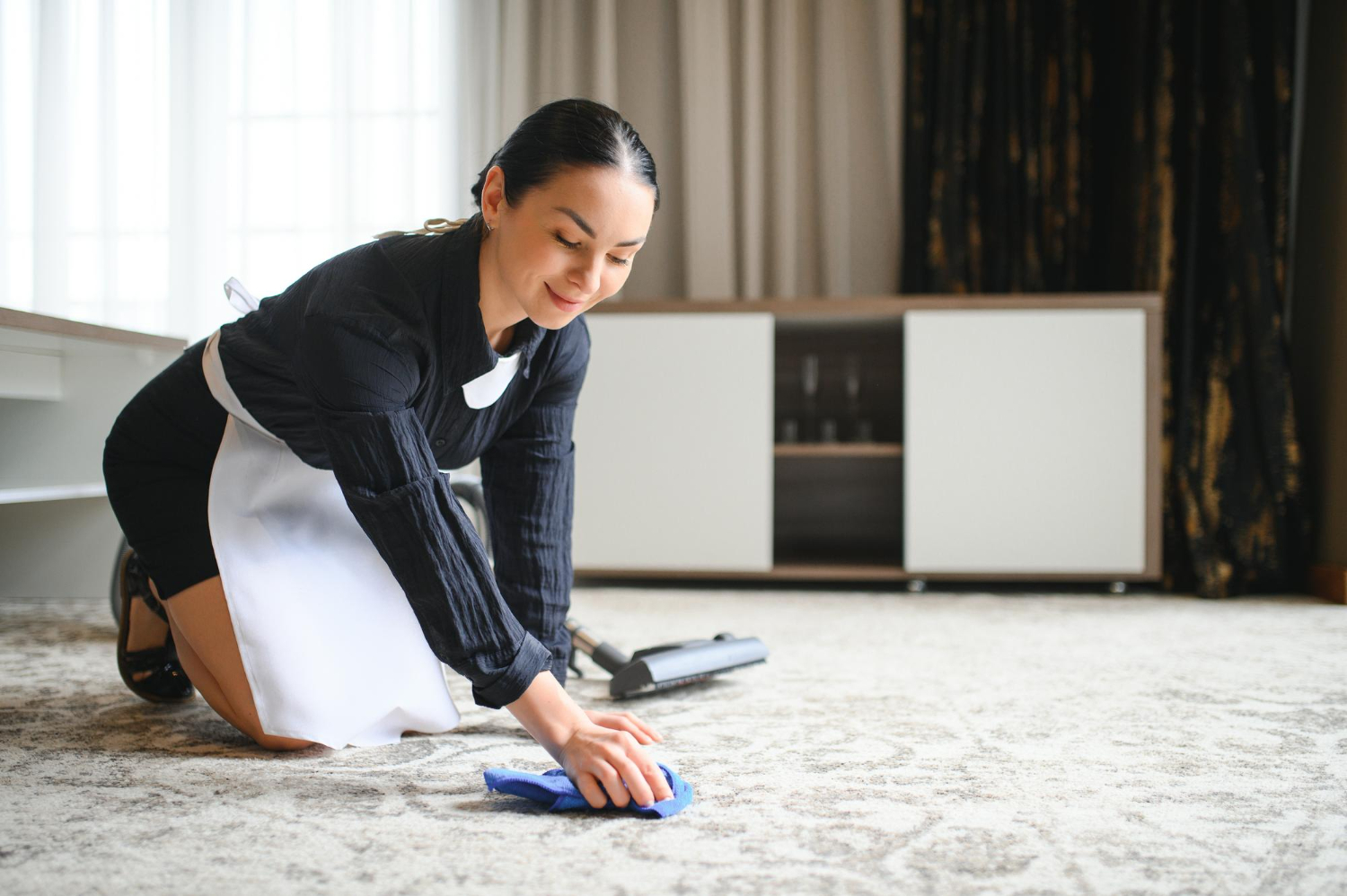Keeping carpet cleaning is essential for both health and aesthetics. Regular carpet cleaning helps remove dirt, allergens, and stains, ensuring a fresher and healthier living environment. Whether someone prefers professional cleaning services or DIY methods, knowing the right techniques and products can make a significant difference.
Many people underestimate the importance of preparation before cleaning carpets. Proper steps, such as vacuuming and addressing stains, are crucial for effective cleaning outcomes. Understanding various cleaning methods, including steam cleaning and spot treatment, allows homeowners to choose the best plan for their needs.
Finding the right cleaning solution also plays a key role in maintaining carpets. Selecting products that are effective yet safe for the environment ensures a healthier home. With the right knowledge and resources, anyone can keep their carpets looking great and lasting longer.
Key Takeaways
- Regular carpet cleaning improves air quality and appearance.
- Preparation before cleaning enhances the effectiveness of the process.
- Choosing the right cleaning solutions promotes safety and health.
Understanding Carpet Cleaning
Carpet cleaning involves knowing the different types of fibers and the common stains that can occur. This knowledge helps maintain carpets more effectively and prolongs their life.
Types of Carpet Fibers
Carpets are made from various fibers, each with unique qualities. The most common types include:
- Nylon: Known for its durability and resilience, making it suitable for high-traffic areas. It resists stains but can be prone to fading.
- Polyester: Soft and comfortable, it offers good color retention but may wear down faster than nylon.
- Wool: A natural fiber that is durable and has good insulating properties. It can be more expensive and requires special care to prevent staining.
- Olefin: Often used in indoor/outdoor carpets, it is resistant to moisture and mold, but can be less durable than other fibers.
Understanding these fibers helps homeowners choose the right cleaning method to avoid damage.
Common Carpet Stains and Problems
Carpets can face various stains and issues. Some common stains include:
- Food and Drink Stains: Such as coffee, wine, or grease, which can penetrate fibers if not treated quickly.
- Pet Stains: Urine and feces can be particularly challenging due to odors and potential damage to fibers.
- Dirt and Mud: Often tracked in from outside, leading to ground-in stains.
Additional problems can arise, such as:
- Allergens: Dust mites, pet dander, and pollen can become trapped in carpet fibers, affecting indoor air quality.
- Mold and Mildew: Excess moisture can lead to mold growth, especially in humid environments.
Identifying these stains and problems is crucial for selecting the right cleaning approach.
Pre-Cleaning Preparations
Preparing the area before carpet cleaning is essential for achieving the best results. This phase involves clearing the space and addressing any spots or stains that may require extra attention.
Clearing the Area
Before starting the carpet cleaning process, it is important to clear the area of furniture and other items. This allows for a thorough cleaning and ensures no spots are missed.
- Remove Furniture: Take away any tables, chairs, and decorations that could obstruct the cleaning process.
- Check Under Rugs: Move any smaller rugs and mats so the entire carpet can be cleaned uniformly.
- Dust and Debris: Wipe surfaces like baseboards and shelves to avoid dust falling onto the freshly cleaned carpet.
A clean area not only helps the cleaners access the carpet but also prevents dirt from settling back down during cleaning.
Spot Treatment Basics
Addressing spots and stains before the main cleaning is vital. Early attention can prevent these marks from setting.
- Identify Stains: Look for visible stains in the carpet. Common areas often include entryways and near furniture.
- Quick Response: The faster a spill is treated, the easier it is to clean. Use a clean cloth to blot the spill rather than rubbing.
- Pretreatment Products: Apply a suitable spot treatment spray or powder specifically made for carpets. Follow the instructions on the label for the best results.
By treating stains promptly and effectively, they are less likely to reappear after the main cleaning process.
Carpet Cleaning Techniques
Various methods exist for cleaning carpets effectively. Understanding these techniques helps in choosing the best option for specific carpet types and stains. Below are four common approaches to carpet cleaning.
Hot Water Extraction
Hot water extraction is a popular method for deep cleaning carpets. This technique involves spraying hot water mixed with cleaning solution into the carpet fibers.
The process helps to loosen and dissolve dirt and stains. After applying the solution, a powerful vacuum removes the water, soil, and dirt.
It’s essential to ensure that the carpet dries thoroughly after this method to prevent mold or mildew. Professional cleaners often use this method, but homeowners can also rent machines designed for this purpose.
Dry Cleaning Methods
Dry cleaning methods use minimal moisture, making them suitable for delicate carpets. One common dry cleaning technique involves applying a dry cleaning powder that absorbs dirt and oils.
This powder is spread over the carpet and then agitated with a machine or manually. After allowing it to sit for a specified time, it is vacuumed away.
Another method includes using a foam cleaner, which also requires minimal drying time. This approach makes dry cleaning an excellent choice for homes needing quick drying.
Shampooing Carpets
Shampooing carpets is a well-known cleaning method that can be done at home or by professionals. This process typically involves using a carpet shampoo mixture.
The shampoo is applied to the carpet using a machine or by hand. It is worked into the fibers to lift dirt and stains.
Once the carpet has been shampooed, it is rinsed and allowed to dry. This method is effective at removing surface dirt but may leave some residue if not rinsed properly.
Encapsulation
Encapsulation is an advanced cleaning technique that is gaining popularity. This method involves using a special synthetic detergent that crystallizes when it dries.
First, the cleaner is applied to the carpet, which encapsulates dirt particles. Once it dries, the dried crystals can be easily vacuumed away.
Encapsulation is effective for routine maintenance, as it requires less water and allows carpets to dry quickly. It’s an excellent option for busy households or commercial spaces with high foot traffic.
Selecting Cleaning Solutions
Choosing the right carpet cleaning solutions is vital for maintaining clean and fresh carpets. It involves deciding between chemical and natural products and selecting treatments that reduce allergens in the home.
Chemical Vs. Natural Solutions
Carpet cleaning solutions can be grouped mainly into chemical and natural options. Chemical solutions are often more powerful and can provide faster results. Products like Bissell DeepClean Pro and Hoover Renewal are well-known for their ability to tackle tough stains. These products may use enzymes or surfactants that break down dirt and grime effectively.
In contrast, natural solutions use ingredients derived from plants or minerals. They are generally safer for pets and children. Options such as vinegar, baking soda, or specialized brands like Rocco & Roxie focus on using non-toxic ingredients. While they may take longer to work, many users prefer them for everyday cleaning and light stains.
Allergen-Reducing Products
Allergen-reducing carpet cleaning products are important for households with allergy sufferers. These solutions aim to remove dust mites, pet dander, and pollen trapped in carpets. Products with certifications such as the Asthma and Allergy Foundation of America may be particularly beneficial.
Many carpet cleaners now feature anti-allergen properties. For example, Bissell includes Scotchgard in some of their formulas to protect against future stains. Additionally, natural options like essential oil-infused products can help neutralize allergens without harsh chemicals. Choosing the right allergen-reducing product can create a healthier environment in the home.
Carpet Maintenance Tips
Taking care of carpets is vital to keep them looking fresh and lasting longer. Regular maintenance can prevent dirt buildup and stains from becoming permanent. Here are important practices to maintain carpets effectively.
Regular Vacuuming
Vacuuming is essential for carpet maintenance. It should be done at least once a week. In high-traffic areas, increase this to two or three times a week.
- Technique: Move slowly and change directions. This helps lift dirt better from the fibers.
- Equipment: Use a vacuum with strong suction and a good brush roll.
This will prevent dirt from settling deep, which can damage the fibers over time. Regular vacuuming keeps carpets looking vibrant and can reduce allergen buildup.
Immediate Stain Management
Prompt attention to stains can make a big difference. After a spill, it’s crucial to act fast.
- Blot, Don’t Scrub: Use a clean cloth to blot the area. Scrubbing can damage the fibers.
- Homemade Solutions: A mix of 3 tablespoons of dish soap, 1 tablespoon of vinegar, and 2 cups of water can be effective for many stains.
- Application: Apply the solution with a cloth, blotting until the stain lifts.
Always test any cleaner on a small area first. Cleaning up immediately prevents stains from setting, making them easier to remove.
Professional Cleaning Schedules
In addition to regular home care, professional cleaning plays a key role. Many experts recommend having carpets cleaned every 12 to 18 months.
- Deep Cleaning: Professionals use equipment that reaches deep into the fibers, removing dirt and allergens.
- Products: Ensure the cleaners are certified and suitable for your carpet type.
- Drying Time: After cleaning, allow carpets to dry fully. Open windows or use fans to speed up this process.
Setting a schedule for professional cleaning helps maintain the carpet’s appearance and extends its life.
Environmental Considerations
Carpet cleaning has important impacts on both health and the environment. By adopting eco-friendly practices and managing waste properly, it is possible to reduce negative effects and promote sustainability in this household task.
Eco-Friendly Practices
Using eco-friendly cleaning products is crucial for reducing harmful chemical exposure. Traditional carpet cleaners often contain pollutants that can harm indoor air quality. Instead, choosing biodegradable options or natural ingredients can make a significant difference.
Using a vacuum cleaner equipped with HEPA filters is also beneficial. This type of vacuum traps allergens and dust that ordinary vacuums might release back into the air. Regular vacuuming will not only help keep carpets clean but also support a healthier home environment.
Other eco-friendly practices include using less water during cleaning and opting for professional services that emphasize sustainability. Many companies now focus on green methods, ensuring minimal environmental impact.
Recycling and Disposal of Waste
Proper disposal of waste created during carpet cleaning is vital. Old carpets and cleaning supplies can release harmful substances into the environment if not managed correctly. It’s important to recycle materials whenever possible.
Many communities offer carpet recycling programs. These programs can transform used carpets into new products, reducing landfill waste. This process often involves shredding carpets and repurposing the fibers.
Additionally, using non-toxic cleaning agents allows for safer disposal methods. Avoid pouring chemicals down drains or into the ground. Instead, check local regulations for disposing of hazardous materials safely. By taking these steps, individuals can contribute to a healthier planet.



